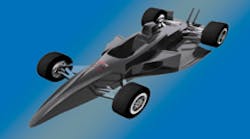Faced with pressure to keep costs down and boost competition and safety, an advisory committee for the IZOD Indy Racing League (IRL) has come up with a two part solution. Starting in 2012, IndyCars will have a, single chassis manufacturer, but teams will be free to choose their own bodywork – within safety and cost constraints.
Current chassis builder Dallara Automobili, Parma, Italy, will build the 2012 chassis, dubbed the IndyCar Safety Cell, through 2015. It includes everything but the driver’s seat and is designed for ovals and road courses. It also improves visibility and head, leg, and back protection for drivers. Anti-interlock features keep the wheels on one car from tangling with a competitor’s wheels, an occurrence that can launch one or both cars into the air.
The new chassis will cost $349,000. That’s 45% less than cars racing this year. Total weight will drop 185 lb to 1,380 lb. The minimum weight won’t be decided for a while and will depend on engine weight and other supplier inputs. Teams expect to take delivery of their chassis in December 2011, and Open Tests will be scheduled before the first race of 2012.
While all teams will use the IndyCar Safety Cell, any manufacturer can produce bodywork including front and rear wings, sidepods, and engine covers. Aero kits must be approved by the IndyCar Series, be available to all teams, undergo safety testing, and cost no more than $70,000. Each team can race two different aero kits from any manufacturer during a season.
Dallara’s aero kit, which will be available in 2012 will initially cost $36,000, increasing to the $70,000 ceiling in 2013.
Dallara has also pledged to build a new facility where it will build the 2012 design in Speedway, Ind., near IRL headquarters and the Brickyard, home of the Indianapolis 500. Early in the planning process for the new design, the advisory committee made clear that U.S.-built designs were strongly preferred. Economic incentives from Indiana enticed would-be chassis builders to propose locating their manufacturing operations there.
The Dallara facility will house the Dallara USA technical center, official Dallara spare-parts distributor Indy Parts Inc., the Indy Racing Experience, Experiential Marketing Inc., and the Indy Engine Group. An interactive area, cosponsored by Hewlett-Packard, will teach fans how an IndyCar is designed and manufactured, let them see the assembly area, show how vehicle dynamics and racing are simulated, and interact with street-legal race cars and pit stop equipment.
"It’s our goal to reach out and challenge the automotive industry as well as aerodynamic companies," says Tony Purnell, former technical consultant to FIA and founder of Pi Research. "So come on Ford, GM, Lotus, Ferrari. Come on Lockheed and General Electric. Come on you young engineers who might be working in small shops and garages. We’ve done our best to provide the framework for you to showcase your technical prowess without the need for a major raid on your piggybank."
Along with the chassis strategy, IRL rolled out plans for future engines. Starting in 2012, the ethanol-powered engines will be turbocharged with a maximum of six cylinders and no more than 2.4 L in displacement Teams will tune the engines to between 550 and 750 hp, depending on track type. An overtake-assist system will briefly boost horsepower to up to 100 hp.
Together, IndyCar Series officials project the complete rolling chassis/engine package to cost each team less than $1 million.
"Historically, increased competition means increased costs. We have a solution that solves both of those challenges. We’ll create an opportunity for competition, innovation, and relevant technology while reducing the cost of participation nearly in half," says IndyCar Series president of competition and racing operations Brian Barnhart.
Resources
Dallara Automobili, http://www.dallara.it/
Experiential Marketing, Inc., http://www.experientialmarketinginc.com/
Hewlett-Packard, http://www.hp.com/
FIA, http://www.fia.com/
Indy Engine Group, http://www.indyenginegroup.com/
Indy Parts, Inc., http://www.indypartsinc.com/
Indy Racing Experience, http://www.indyracingexperience.com/
IZOD Indy Racing League, http://www.indycar.com/
Pi Research, http://www.piresearch.com/
